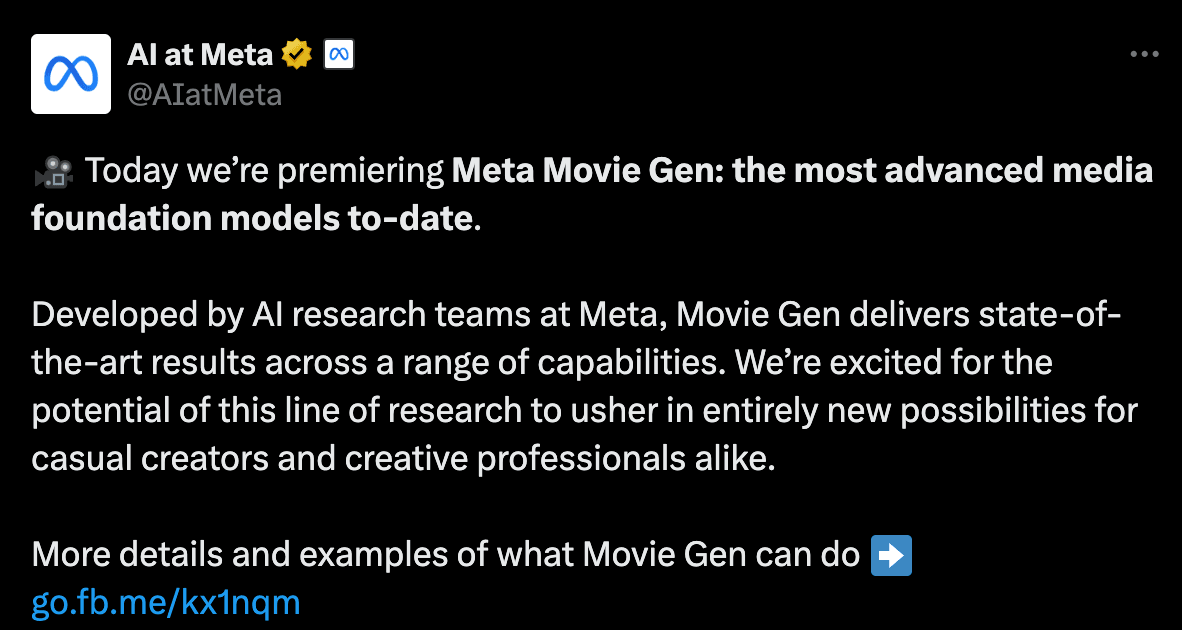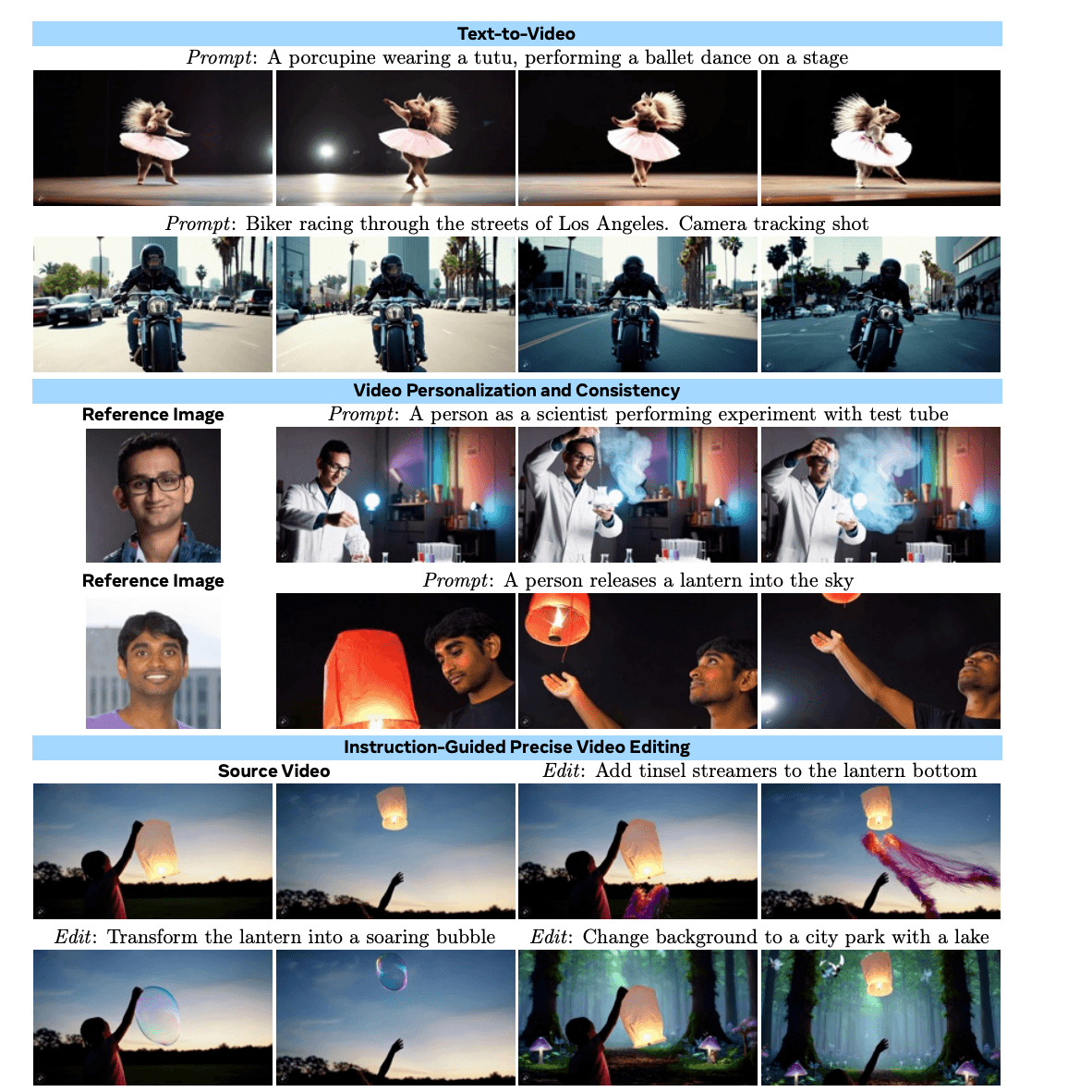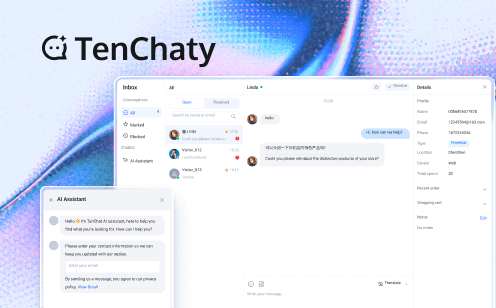
1. Introduction
In the rapidly evolving landscape of artificial intelligence, the race to develop increasingly sophisticated AI-powered tools has reached a new frontier: video generation. Meta, the tech giant formerly known as Facebook, has recently unveiled its groundbreaking AI video generation system, Meta Movie Gen. This announcement comes at a time when the AI community is still buzzing with anticipation over OpenAI's Sora, making Meta's timely release all the more significant.
Meta Movie Gen represents a leap forward in AI-driven content creation, offering a suite of features that not only match but in some areas surpass the capabilities of its competitors. As we delve into the intricacies of this new technology, we'll explore how Meta Movie Gen is poised to revolutionize the way we create, edit, and interact with video content.
2. Core Features of Movie Gen
2.1 High-quality Video Generation
Movie Gen's primary feature is its ability to generate high-quality videos from text prompts. The system utilizes a 30B parameter Transformer model, optimized for both text-to-image and text-to-video tasks. This powerful model can create videos up to 16 seconds long at 16 frames per second, with a resolution of 1080p.
What sets Movie Gen apart is its ability to reason about complex visual concepts:
Object Motion: The model can accurately depict the movement of objects in a scene. For example, given a prompt like "A red ball bouncing down a spiral staircase", Movie Gen can generate a video showing the ball's realistic trajectory and speed changes as it descends.
Subject-Object Interactions: Movie Gen excels at portraying interactions between different elements in a scene. A prompt such as "A cat playing with a robotic toy mouse on a kitchen floor" would result in a video showing realistic interactions between the cat, the toy, and the environment.
Camera Motion: The system can simulate various camera movements, adding dynamism to the generated videos. For instance, a prompt like "A drone shot flying over a bustling cityscape at sunset" would produce a video with smooth, sweeping camera motions that mimic a drone's flight path.
2.2 Personalized Video Creation
Movie Gen takes personalization to a new level with its ability to generate videos featuring specific individuals based on provided images. This feature allows users to become the stars of AI-generated content, opening up exciting possibilities for personalized storytelling and marketing.
The process works as follows:
- A user provides an image of a person.
- The user then gives a text prompt describing the desired scene or action.
- Movie Gen combines these inputs to create a video featuring the person from the image, integrated seamlessly into the described scenario.
For example:
- Input Image: A photo of John wearing a business suit
- Text Prompt: "A person giving a TED talk on sustainable energy to a large audience"
- Output: A video showing John, in his business suit, confidently delivering a TED talk on stage, complete with audience reactions and dynamic camera angles.
This feature maintains impressive fidelity to the person's appearance and mannerisms, making it ideal for creating personalized content for marketing, education, or entertainment purposes.
2.3 Precise Video Editing
One of Movie Gen's most impressive capabilities is its precise video editing functionality. Unlike traditional editing tools that require specialized skills or other AI tools that lack precision, Movie Gen can perform targeted edits while preserving the original content's integrity.
The system accepts both a video and a text prompt as input, then executes the desired edits with remarkable accuracy. These edits can be:
Localized Changes: Adding, removing, or replacing specific elements within the video. Example: "Remove the red car from the street scene and replace it with a blue bicycle"
Global Modifications: Altering the overall style, background, or atmosphere of the video. Example: "Change the sunny beach setting to a snowy mountain landscape"
Movie Gen's editing prowess extends to complex tasks like:
- Changing the time of day in a video
- Altering weather conditions
- Modifying the style of clothing worn by people in the scene
- Adding or removing objects or characters
For instance, given a video of a person walking through a park on a sunny day, a user could prompt: "Make it a rainy evening and add an umbrella to the person's hand". Movie Gen would then adjust the lighting, add rain effects, and seamlessly integrate an umbrella into the person's grasp, all while maintaining the original video's continuity and realism.
2.4 Audio Generation and Synchronization
Perhaps one of the most impressive and unique features of Movie Gen is its integrated audio generation capability. The system includes a 13B parameter audio generation model that can create high-quality, synchronized audio for videos up to 45 seconds long.
This audio model can generate:
- Ambient Sound: Background noises that match the video's setting
- Sound Effects (Foley): Specific sounds corresponding to on-screen actions
- Instrumental Background Music: Mood-appropriate music that enhances the video's atmosphere
The audio generation process is remarkably versatile:
- It can take a video as input and generate fitting audio without additional prompts.
- Users can provide text prompts to guide the audio generation, specifying desired sounds or music styles.
- For longer videos, Movie Gen employs an audio extension technique to create coherent audio tracks of arbitrary length.
Example Scenarios:
- For a video of a bustling city street, Movie Gen might generate ambient city sounds like traffic, distant conversations, and occasional honking.
- Given a video of a person cooking with the prompt "Add cheerful kitchen sounds and light jazz music", the system would generate appropriate cooking noises (chopping, sizzling) along with a subtle jazz soundtrack.
- For an action sequence, Movie Gen could add dramatic music, sound effects for movements and impacts, and atmospheric sounds to heighten tension.
The audio generation feature stands out for its ability to align perfectly with the video content, creating a cohesive audiovisual experience that enhances the overall quality and immersion of the generated content.
3. Technical Highlights and Underlying Principles
3.1 Model Architecture
Movie Gen consists of two primary components: Movie Gen Video and Movie Gen Audio.
Movie Gen Video: This is a 30B parameter Transformer model capable of generating high-definition videos from a single text prompt. It can produce 16-second videos at 16 frames per second, which translates to processing approximately 73K video tokens.

Movie Gen Audio: This is a 13B parameter Transformer model that accepts video input along with optional text prompts to generate high-fidelity audio synchronized with the video.
3.2 Training Process
The training of Movie Gen Video follows a two-stage process: pre-training and fine-tuning.
Pre-training Stage: During this phase, the model undergoes joint training on massive video-text and image-text datasets. The scale of this training data is impressive, encompassing O(100)M videos and O(1)B images.
Fine-tuning Stage: After pre-training, researchers carefully select a smaller subset of high-quality videos for supervised fine-tuning.
3.3 Flow Matching as Training Objective
One of the most innovative aspects of Movie Gen is its use of flow matching as a training objective, departing from the more common diffusion-based approaches.
Compared to diffusion models, flow matching offers several advantages:
- More efficient training
- Lower computational costs
- Better continuity and consistency in the time dimension of generated results
3.4 Overall Architecture and Data Flow
The system's architecture involves several key components working in tandem:
- Temporal AutoEncoder (TAE)
- Text Encoders
- Generative Model
- Decoder
3.5 Technical Innovations
Movie Gen Video incorporates several technical innovations:
- Factorized Learnable Positional Embedding
- Linear-Quadratic t-schedule
- Temporal Tiling
4. Comparison with Competitors
4.1 Meta Movie Gen vs. OpenAI's Sora
While Sora has generated significant buzz, Movie Gen appears to match or exceed it in several areas:
- Availability
- Audio generation
- Editing capabilities
- Transparency
4.2 Performance Across Various Tasks
Meta claims that Movie Gen outperforms existing models in several key areas:
- Video generation
- Personalized video creation
- Video editing
- Audio-video synchronization
5. Potential Applications
5.1 Film Production
Movie Gen has the potential to revolutionize various aspects of film production:
Pre-visualization: Directors and producers can quickly generate rough drafts of scenes, helping to visualize complex sequences before committing to expensive shoots.
Special Effects: The technology could be used to create realistic special effects, potentially reducing the need for costly CGI in some instances.
Background Generation: Movie Gen could generate detailed backgrounds or crowd scenes, saving time and resources in set design and extras management.
Script-to-Screen: Writers could use the tool to quickly visualize their scripts, helping to refine narratives and pitch ideas more effectively.
Post-production: The video editing capabilities could streamline the post-production process, allowing for quick iterations and adjustments.
5.2 Content Creation
In the realm of content creation, Movie Gen offers numerous possibilities:
Social Media Content: Influencers and marketers can quickly generate high-quality, engaging video content for platforms like Instagram, TikTok, and YouTube.
Personalized Content: Businesses can create customized video messages for clients or employees, enhancing engagement and communication.
Virtual YouTubers and Streamers: The technology could be used to create or enhance virtual personalities for online content creation.
News and Journalism: Rapid generation of visual aids or reenactments for news stories, enhancing the visual storytelling aspect of journalism.
Music Videos: Artists could use Movie Gen to create innovative and cost-effective music videos, exploring creative concepts without the need for extensive production resources.
5.3 Education and Training
Movie Gen has significant potential in educational and training contexts:
Interactive Learning Materials: Educators can create engaging, visual explanations of complex concepts, making learning more accessible and interesting.
Virtual Field Trips: Schools could use the technology to generate immersive "visits" to historical sites, natural wonders, or even abstract concepts like cellular biology.
Corporate Training: Companies can develop customized training videos tailored to their specific needs and corporate culture.
Language Learning: The tool could generate situational videos for language learners, helping them understand context and usage in real-world scenarios.
Medical Training: Generation of realistic medical scenarios for training healthcare professionals without the need for actors or expensive simulations.
5.4 Marketing and Advertising
The marketing and advertising industry stands to benefit greatly from Movie Gen:
Personalized Ads: Brands can create customized video advertisements tailored to individual consumer preferences and behaviors.
Rapid Prototyping: Ad agencies can quickly generate multiple versions of an ad concept for testing and client approval.
Product Demonstrations: Companies can easily create and update product demo videos, showcasing features in various contexts.
Virtual Spokespersons: Brands could create consistent virtual brand ambassadors for use across various campaigns and platforms.
Event Marketing: Generation of promotional videos for events, with the ability to quickly update content as details change.
6. Industry Impact
6.1 Advancement in AI Video Generation Field
Movie Gen represents a significant leap forward in AI video generation:
Quality Improvement: The high-quality output sets a new standard for AI-generated video content.
Versatility: The combination of video generation, editing, and audio synchronization in one tool pushes the boundaries of what's possible with AI in content creation.
Accessibility: By simplifying complex video production tasks, Movie Gen makes high-quality video creation more accessible to a broader range of users.
Research Catalyst: The innovations in Movie Gen are likely to spur further research and development in the field of AI-driven content creation.
Ethical Considerations: The capabilities of Movie Gen will likely accelerate discussions around the ethical use of AI in media production, potentially leading to new guidelines and standards.
6.2 Disruption to Traditional Video Production Industry
The introduction of Movie Gen could significantly disrupt the traditional video production industry:
Democratization of Video Production: Small businesses and individuals may be able to produce professional-quality videos without extensive resources or technical expertise.
Job Market Shifts: While some roles in traditional video production may be affected, new roles focused on AI-assisted content creation are likely to emerge.
Cost Reduction: The ability to quickly generate and edit video content could lead to significant cost reductions in video production across various industries.
Workflow Changes: Production processes may need to be reimagined to incorporate AI tools like Movie Gen effectively.
Quality Expectations: As AI-generated content improves in quality, it may raise the bar for what's considered acceptable in video production, potentially challenging smaller production companies.
7. Future Outlook
7.1 Further Development Directions for Movie Gen
Looking ahead, Movie Gen is likely to evolve in several directions:
Increased Resolution and Length: Future versions may be able to generate longer videos at even higher resolutions, possibly up to 4K or 8K.
Enhanced Interactivity: Integration with VR and AR technologies could allow for the creation of immersive, interactive video experiences.
Real-time Generation: Improvements in processing speed could enable real-time video generation, opening up possibilities for live content creation.
Expanded Audio Capabilities: Future iterations might include more advanced audio generation, including realistic voice synthesis and complex musical compositions.
Multi-lingual Support: Development of capabilities to generate content in multiple languages, including lip-syncing for dubbed content.
7.2 Future Trends in AI Video Generation Technology
The broader field of AI video generation is likely to see several trends:
Integration with Other AI Technologies: Combining video generation with natural language processing, emotion recognition, and other AI fields for more sophisticated content creation.
Ethical AI Development: Increased focus on developing AI video generation tools that can detect and prevent the creation of deepfakes or misleading content.
Personalization at Scale: Advancements in AI could allow for the creation of highly personalized video content for large audiences, tailored to individual preferences and contexts.
Cross-platform Optimization: Future tools may be able to automatically optimize video content for various platforms and devices.
AI-Human Collaboration: Development of interfaces and workflows that allow for seamless collaboration between human creators and AI tools, enhancing creativity rather than replacing human input.
As AI video generation technology like Movie Gen continues to advance, it promises to reshape the landscape of content creation, offering new possibilities while also presenting new challenges for industries to navigate. The key to harnessing its potential will lie in balancing innovation with ethical considerations and finding ways to augment human creativity rather than replace it.
8. Conclusion
Meta Movie Gen represents a significant milestone in the evolution of AI-generated content. Its combination of high-quality video generation, precise editing capabilities, personalization features, and integrated audio generation sets a new standard in the field. As the technology continues to evolve, we can expect to see even more impressive capabilities and applications emerge, potentially reshaping industries from entertainment to education and beyond.
The introduction of Movie Gen not only showcases Meta's technological prowess but also highlights the rapid pace of innovation in AI. As these tools become more sophisticated and accessible, they have the potential to democratize content creation, enabling individuals and small teams to produce high-quality video content that was previously only possible with significant resources.
However, with great power comes great responsibility. As we move forward, it will be crucial to address the ethical implications of such powerful AI tools, ensuring they are used responsibly and do not contribute to the spread of misinformation or the creation of harmful content.
In conclusion, Meta Movie Gen marks a significant step forward in AI-driven content creation, opening up new possibilities and challenges that will shape the future of media production and consumption.


